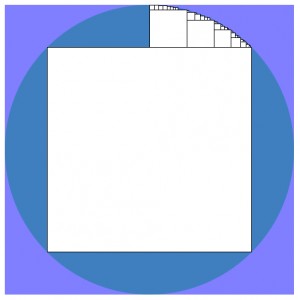
Here’s a fun algorithm: put the biggest possible square into a circle. Then looking at just the right side of the space above that square, add in the biggest possible square, then add in the biggest square into the space that remains, and so on, filling up that octant of the circle. It’s not too hard. My solution’s after the break. Continue reading
Category Archives: Uncategorized
Circle Packing In A Square
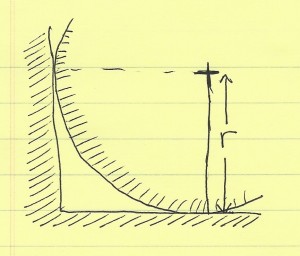 Given a circle of radius r, and around it a box of side 2r. We want to put another circle into the gap between the circle and a corner of the box. Find a formula for the center and radius of the largest circle that can be fit into that space. This might be a little trickier than you first think.
Given a circle of radius r, and around it a box of side 2r. We want to put another circle into the gap between the circle and a corner of the box. Find a formula for the center and radius of the largest circle that can be fit into that space. This might be a little trickier than you first think.
The solution’s after the break, but don’t give up too soon! Continue reading
Mathematica Mangles Input Data
Here’s the short version: If you calculate data in almost any programming language, very large and very small numbers will be printed using a near-universal standard called scientific notation. If you read this data into Mathematica, a system designed for scientific and engineering mathematics, it quietly replaces each one of those numbers with a different, essentially random value. Thus everything you do with your data from that point is untrustworthy. This is an inexcusable and potentially dangerous situation. Continue reading
Paper Cutting
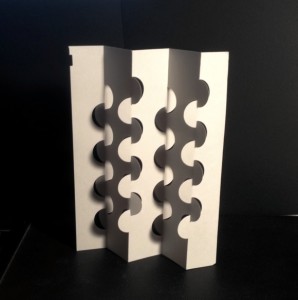 A friend has been egging me on to buy a gadget called the Silhouette Cameo. You can think of it as a printer, but instead of a print head it has a little blade that can cut through paper, up to pretty thick cardstock. It comes with a surprisingly powerful editor, like a baby version of Adobe Illustrator. It’s surprisingly easy to use. This is my First Thing Ever, cut from a single piece of paper. I think this is going to be a lot of fun! The inspiration for this design came from Paul Jackson’s wonderful The Pop-Up Book.
A friend has been egging me on to buy a gadget called the Silhouette Cameo. You can think of it as a printer, but instead of a print head it has a little blade that can cut through paper, up to pretty thick cardstock. It comes with a surprisingly powerful editor, like a baby version of Adobe Illustrator. It’s surprisingly easy to use. This is my First Thing Ever, cut from a single piece of paper. I think this is going to be a lot of fun! The inspiration for this design came from Paul Jackson’s wonderful The Pop-Up Book.
Babblemumble cube
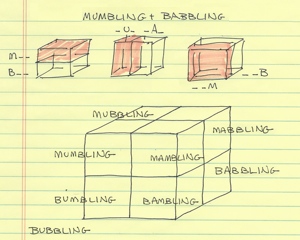 While walking my dog Niko tonight, I was talking to him, as usual. I was just babbling. I was also mumbling. I thought there should be a nice portmanteau word combining babbling and mumbling. Both end with “bling”, so the first three letters have two choices: m/b, u/a, and m/b. That situation can be nicely drawn as a cube. Here are the axes, and the results. Of the eight possibilities, two are already words: in the back-lower-right corner (the cube we can’t see) is bubbling, and in the near-lower-left is bumbling. But the one I like best is bambling. I don’t know, it just feels right. To see a larger view of this image, and another image of all the cubes isolated, click here:
While walking my dog Niko tonight, I was talking to him, as usual. I was just babbling. I was also mumbling. I thought there should be a nice portmanteau word combining babbling and mumbling. Both end with “bling”, so the first three letters have two choices: m/b, u/a, and m/b. That situation can be nicely drawn as a cube. Here are the axes, and the results. Of the eight possibilities, two are already words: in the back-lower-right corner (the cube we can’t see) is bubbling, and in the near-lower-left is bumbling. But the one I like best is bambling. I don’t know, it just feels right. To see a larger view of this image, and another image of all the cubes isolated, click here:
SIGGRAPH Intro to 3D course available for free!
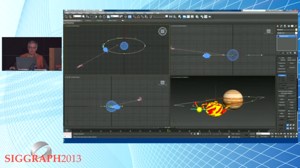 At SIGGRAPH 2013 I gave an invited course titled “Introduction to 3D Computer Graphics.” The good folks at SIGGRAPH recorded the course and have now made it available for free on the SIGGRAPH website. It runs just under 3 hours, but unlike the attendees at the convention center, you can stop and start it whenever you like! The link to the video is: http://siggraphmediablog.blogspot.com/2014/01/siggraph-launches-free-program-offering.html Thanks to Eric Haines for alerting me that this was now available.
At SIGGRAPH 2013 I gave an invited course titled “Introduction to 3D Computer Graphics.” The good folks at SIGGRAPH recorded the course and have now made it available for free on the SIGGRAPH website. It runs just under 3 hours, but unlike the attendees at the convention center, you can stop and start it whenever you like! The link to the video is: http://siggraphmediablog.blogspot.com/2014/01/siggraph-launches-free-program-offering.html Thanks to Eric Haines for alerting me that this was now available.
Sensory Language
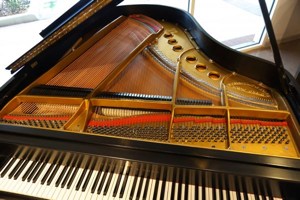 Recently I had my piano tuned (it’s a gorgeous Steinway Model B originally built in 1887, and still going strong! The picture is of a similar, but newer, instrument). After playing it for a while I found that one note was consistently standing out and distracting me each time it sounded. I emailed my tuner, and we corresponded a bit over the nature of the sound. I found myself straining to find words to describe what I was hearing, and I realized that in everyday language, our different senses have very different sizes of vocabularies.
Recently I had my piano tuned (it’s a gorgeous Steinway Model B originally built in 1887, and still going strong! The picture is of a similar, but newer, instrument). After playing it for a while I found that one note was consistently standing out and distracting me each time it sounded. I emailed my tuner, and we corresponded a bit over the nature of the sound. I found myself straining to find words to describe what I was hearing, and I realized that in everyday language, our different senses have very different sizes of vocabularies.
Inksplats! Collection 1
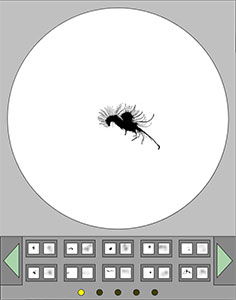 Inksplats! I described how to make these fun little drawings in the previous post. Here are some of the splats I’ve drawn. It’s a lot of fun, and I hope these drawings will help inspire you to make some of your own! To run the interactive Inksplat viewer, just click here: http://www.imaginary-institute.com/support/splats/splatViewer.html.
Inksplats! I described how to make these fun little drawings in the previous post. Here are some of the splats I’ve drawn. It’s a lot of fun, and I hope these drawings will help inspire you to make some of your own! To run the interactive Inksplat viewer, just click here: http://www.imaginary-institute.com/support/splats/splatViewer.html.
How to make Inksplats
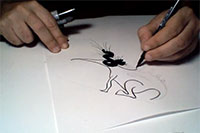 Inksplats are a huge amount of fun. They’re easy to make and you probably have almost all of the materials already. In this post I’ll go over the materials you need, and the step-by-step process for using them to inspire your own creative drawings. To see some of my results, check out the blog post Inksplats Collection 1. Continue reading
Inksplats are a huge amount of fun. They’re easy to make and you probably have almost all of the materials already. In this post I’ll go over the materials you need, and the step-by-step process for using them to inspire your own creative drawings. To see some of my results, check out the blog post Inksplats Collection 1. Continue reading
Some Random Art, Part 2
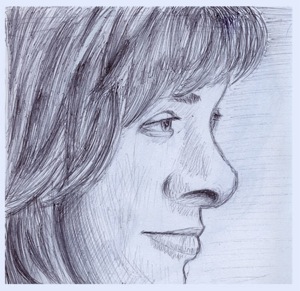 A few more random drawings from my sketchbook. Most of these are in pencil or ballpoint pen, but there’s also one pair in pigment markers, and my first experiment with watercolor. The weird radial streaking on the watercolor background is an artifact of my scanner. Continue reading
A few more random drawings from my sketchbook. Most of these are in pencil or ballpoint pen, but there’s also one pair in pigment markers, and my first experiment with watercolor. The weird radial streaking on the watercolor background is an artifact of my scanner. Continue reading
